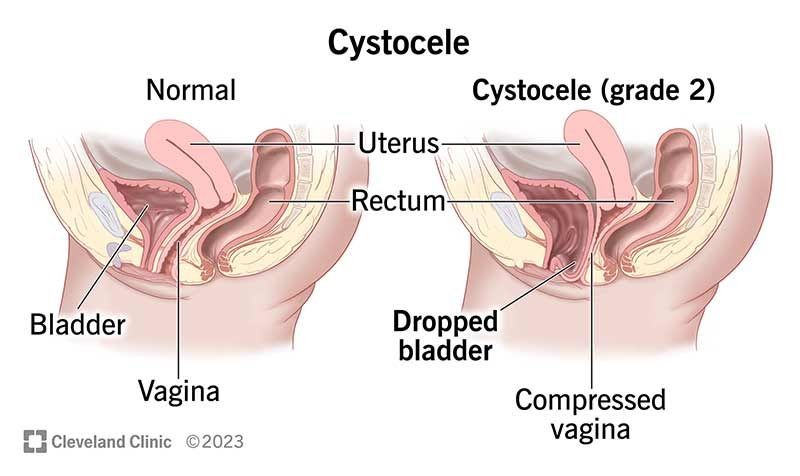
Contents
How Can I Stop My Cystocele From Getting Worse?
The first and most important step to prevent a cystocele from worsening is to change one’s lifestyle.
Additionally, lifestyle medications may be employed.
- Losing weight if overweight or obese because excess pounds strain the pelvic supports of the uterus and the urinary bladder.
- Treatment of allergies and chronic cough, which strain the pelvic floor muscles.
- Smoking cessation is critical.
- Constipation can be avoided by eating high-fiber foods, drinking plenty of clear fluids, and engaging in adequate physical activity.
- Behavior modification: Avoiding activities that strain the pelvic floor may help symptoms from worsening.
Mild cases of cystocele
Those with few or no obvious symptoms are unlikely to require treatment. The doctor may advise periodic visits to monitor their prolapse.
4 first-line treatment options for cystocele
The 4 first-line treatment options for a cystocele includes:
- Pelvic floor muscle exercises or Kegel exercises
- These exercises help strengthen pelvic floor muscles, allowing them to support the bladder and other pelvic organs more effectively.
- A doctor or physical therapist can show how to do these exercises and help a person determine if they are doing them correctly.
- When taught by a physical therapist and reinforced with biofeedback, Kegel exercises may be most effective at relieving symptoms.
- Biofeedback involves the use of monitoring devices to ensure that a person is tightening the right muscles, at the right intensity, and for the right length of time.
- These exercises may help alleviate symptoms, but they may not reduce the size of the prolapse.
- Use the following steps to perform Kegel exercises:
- Contract (tighten) the pelvic floor muscles.
- Hold the contraction for five seconds and then relax for the same amount of time (if too difficult, start with two seconds of holding and three seconds of relaxing).
- Increase the duration of the contraction to 10 seconds at a time.
- Every day, perform three sets of 10 repetitions of these exercises.
QUESTION
What are the different surgical options for cystocele?
If noticeable, unpleasant symptoms continue, the doctor may recommend surgical treatment.
- Often, the surgery is performed vaginally, with the prolapsed bladder being stitched back into place, and any excess vaginal tissue is removed.
- If vaginal tissues appear to be very thin, the doctor may use a special type of tissue graft to reinforce them and increase support.
- If the anterior prolapse is caused by a prolapsed uterus, the doctor may recommend hysterectomy (removing the uterus), as well as repairing the damaged pelvic floor muscles, ligaments, and other tissues.
- If anterior prolapse is accompanied by stress incontinence, the doctor may suggest procedures to support the urethra and alleviate incontinence symptoms.
Most cystocele surgeries are performed vaginally, but an incision in the lower abdomen may be required, especially if laparoscopy or mesh insertion is used.
4 surgical options for cystocele
- The laparoscopic paravaginal repair
- The paravaginal repair is best accomplished through laparoscopy. Sutures are used to reattach the vaginal ceiling to its original point of attachment.
- The bladder may be returned to its normal anatomical position following the paravaginal repair.
- The most anatomically correct repair of a cystocele with the highest cure rate.
- It does not require a vaginal incision and thus, reduces or eliminates the risk of vaginal shortening.
- If a patient has urinary leakage, a laparoscopic Burch procedure can be performed concurrently.
- If there is an associated organ prolapse, a vaginal repair is typically performed by incising and opening the anterior vaginal wall in a surgical procedure called anterior colporrhaphy.
- Before sewing them together, a mesh is inserted into the vaginal wall’s supporting tissue to strengthen it.
- They are used to strengthen bladder supports by attaching the uterus or vaginal vault to one of the bones at the bottom of the spine or to the strong ligaments that cover the sacrum. These can be performed through open or laparoscopic procedures.
- In most cases of cystocele that require this approach or in mild cases where there is an associated descent of the uterus, vaginal hysterectomy with pelvic floor repair is performed. A pelvic floor repair is performed at the same time.
- The most extreme method is to obliterate the vagina, but this prevents sexual intercourse.
- As a result, it is only used to treat frail patients or if several previous procedures have failed.
Currently, the recurrence of prolapse in women who have had surgical repair ranges from 25 to 30 percent. The risk of recurrence is higher in those with etiologic factors, such as being overweight or having a chronic cough.
Identification and repair of both lateral and central vaginal support defects are critical to prevent cystocele recurrence.
What is a cystocele?
A network of muscles, ligaments, and tissues holds a woman’s reproductive and pelvic organs in place. These support structures can deteriorate, causing the bladder, vagina, and even the rectum to sag and droop. These present with pain and symptoms that can interfere with daily life.
A cystocele occurs when the wall between the bladder and the vaginal cavity weakens and the bladder sags into the vaginal space.
12 typical symptoms of a cystocele
- Pelvic pressure, which may worsen while standing or lifting an object
- A feeling of heaviness or fullness in the pelvic area
- A bulge in the vagina
- Lower back pain
- Unexpected bladder leaks during a cough or strenuous activities
- Problems inserting tampons or applicators
- Pelvic pain, discomfort, or a dragging sensation
- Recurrent urine infection
- Incomplete bladder emptying
- Difficulty passing urine
- Pain with intercourse
- Urinary leakage during intercourse
7 causes and risk factors of cystocele
- Pregnancy and vaginal childbirth
- Being overweight or obese
- Repeated heavy lifting
- Straining with bowel movements
- A chronic cough or bronchitis
- Older age (especially true following menopause)
- Some women are born with weaker connective tissue, which makes them more prone to anterior prolapse
How is a cystocele diagnosed?
When patients first complain about cystocele symptoms:
- A doctor will perform a pelvic exam on them while they are lying down or standing.
- Patients are usually asked to fill out a questionnaire so that the doctor can determine how much the symptoms are interfering with their daily lives.
- Urine is tested for bacteria and other infection-related indicators as well.
Finally, urologists may perform bladder tests to determine how well the bladder drains.
- Cystourethrogram (voiding cystogram): This is an X-ray of the bladder taken while the woman is urinating and with the bladder and urethra filled with contrast dye. It demonstrates the bladder’s shape with any blockages.
- Urodynamics: This is a bladder function test. It indicates how much urine the bladder can hold before feeling the need to urinate. It demonstrates the source of the urine leak.
- Magnetic resonance imaging: Can be used to determine the extent of bladder prolapse.
Other tests may be required to determine whether there are any problems in other areas of the urinary system.
Cystocele may be graded for treatment purposes depending on the diagnosis.
- Grade I or mild: The bladder only droops a short distance into the vagina.
- Grade II or severe: The bladder has sunk far enough into the vagina to reach the opening.
- Grade III or advanced: The bladder protrudes through the vaginal opening.
Usually, grade I cystocele does not necessitate treatment. However, it is important to consult with a gynecologist regularly to determine whether the condition is worsening.
Exercises to strengthen the pelvic floor are recommended. Other types of treatment, such as estrogen therapy or a pessary device to keep the bladder in place, could be considered in more severe cases.
In extreme cases, surgery to return the bladder to its normal position may be an option.
In extreme cases, surgery to return the bladder to its normal position may be an option.


